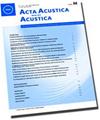Role of Plate Length on Noise from Wall Jets
Q1 Arts and Humanities
引用次数: 3
Abstract
The present study experimentally investigates the effect of the growth of inner layer on noise emission characteristics of wall jets. The plate length L considered for the current study vary in the range of L/h = 2.5 to 30, where h is the nozzle height. The jet is issued from a nozzle having the exit dimensions of 20 cm in width and 2 cm in height h. The jet Reynolds number, based on the nozzle height and jet exit velocity Uj, is varied up to 7.0 · 104. Acoustic measurements revealed the distinct variations in the noise levels with different plate lengths. The L/h = 2.5 wall jet has an increase in noise levels by around 10 dB compared to that of a free jet (background noise). Wall jets in the range of L/h = 5 to 20 radiate higher noise levels compared to other plates, while the least noise emissions are observed from fully developed wall jets (L/h > 20). The significant sources identified for noise emissions are the trailing edge and the secondary shear layer in the wall jets. The low frequency noise corresponding to the Strouhal number (based on h) below 0.2 is characterized as the trailing edge noise. The spectra of the wall jets collapse in the Strouhal number range (based on the inner layer thickness of wall jets) of ∼0.2 to 1.0 indicating the secondary shear layer noise of wall jets.板长对壁面射流噪声的影响
本文通过实验研究了内层生长对壁面射流噪声发射特性的影响。本研究考虑的板长L在L/h = 2.5到30的范围内变化,其中h为喷嘴高度。射流从出口尺寸为20厘米宽、2厘米高的喷嘴发出。基于喷嘴高度和射流出口速度Uj的射流雷诺数变化最大可达7.0·104。声学测量揭示了不同板长的噪声水平的明显变化。与自由射流(背景噪声)相比,L/h = 2.5壁射流的噪声水平增加了约10 dB。在L/h = 5 ~ 20范围内的壁面射流比其他板辐射出更高的噪声水平,而当L/h > 20时,壁面射流的噪声最小。确定的噪声排放的重要来源是尾缘和壁面射流中的二次剪切层。低于0.2的Strouhal数(基于h)所对应的低频噪声表征为后缘噪声。壁面射流的谱线在Strouhal数(基于壁面射流内层厚度)为~ 0.2 ~ 1.0的范围内崩溃,表明壁面射流存在二次剪切层噪声。
本文章由计算机程序翻译,如有差异,请以英文原文为准。
求助全文
约1分钟内获得全文
求助全文
来源期刊
CiteScore
2.60
自引率
0.00%
发文量
0
审稿时长
6.8 months
期刊介绍:
Cessation. Acta Acustica united with Acustica (Acta Acust united Ac), was published together with the European Acoustics Association (EAA). It was an international, peer-reviewed journal on acoustics. It published original articles on all subjects in the field of acoustics, such as
• General Linear Acoustics, • Nonlinear Acoustics, Macrosonics, • Aeroacoustics, • Atmospheric Sound, • Underwater Sound, • Ultrasonics, • Physical Acoustics, • Structural Acoustics, • Noise Control, • Active Control, • Environmental Noise, • Building Acoustics, • Room Acoustics, • Acoustic Materials and Metamaterials, • Audio Signal Processing and Transducers, • Computational and Numerical Acoustics, • Hearing, Audiology and Psychoacoustics, • Speech,
• Musical Acoustics, • Virtual Acoustics, • Auditory Quality of Systems, • Animal Bioacoustics, • History of Acoustics.

 求助内容:
求助内容: 应助结果提醒方式:
应助结果提醒方式:


